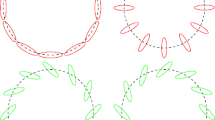Abstract
Detailed models of observed interacting galaxies suffer from the extended parameter space. Here, we present results from our code MINGA which couples an evolutionary optimization strategy (a genetic algorithm) with a fast N-body method. MINGA allows for an automatic search of the optimal region(s) in parameter space within a few hours to a few days of CPU time on a modern PC by investigating of the order of 105 models. We demonstrate its applicability by modelling the HI intensity and velocity maps of the interacting system M51 and NGC 5195. We get a good fit for the HI intensity map and we can reproduce the counter-rotation feature of the HI arm. Our result corroborates the results of Salo and Laurikainen (2000) who favour a model with multiple passages through M51's disk.
Similar content being viewed by others
References
Hernquist, L.: 1990, in: R. Wielen (ed.), Dynamics and Interactions of Galaxies, p. 108.
Rots, A.H., Bosma, A., van der Hulst et al.: 1990, AJ 100, 387.
Salo, H. and Laurikainen, E.: 2000, MNRAS 319, 377.
Theis, Ch.: 1999, Rev. Mod. Ast. 12, 309.
Theis, Ch. and Kohle, S.: 2001, A&A 370, 365.
Toomre, A. and Toomre, J.: 1972, ApJ 178, 623.
Wahde, M.: 1998, A&A Suppl. Ser. 132, 417.
Wahde, M. and Donner, K.: 2001, A&A 379, 115.
Author information
Authors and Affiliations
Rights and permissions
About this article
Cite this article
Theis, C., Spinneker, C. M51 revisited: A genetic algorithm approach of its interaction history. Astrophysics and Space Science 284, 495–498 (2003). https://doi.org/10.1023/A:1024056211087
Issue Date:
DOI: https://doi.org/10.1023/A:1024056211087




